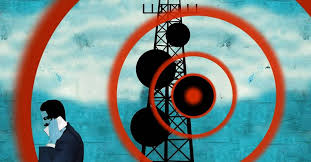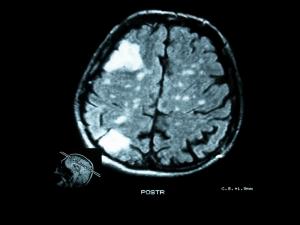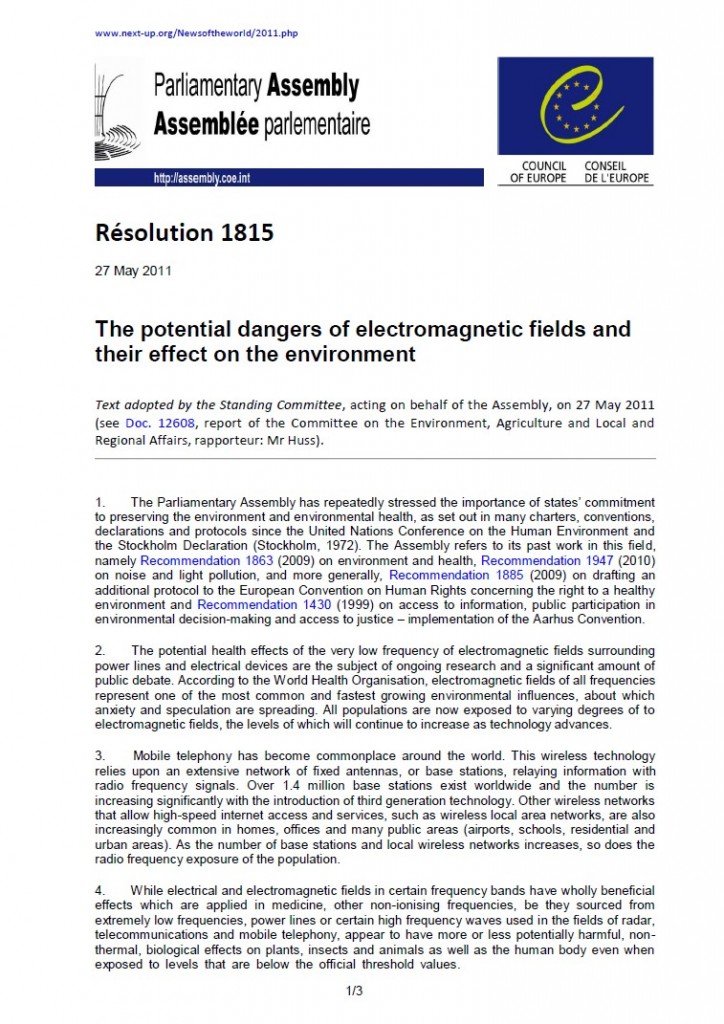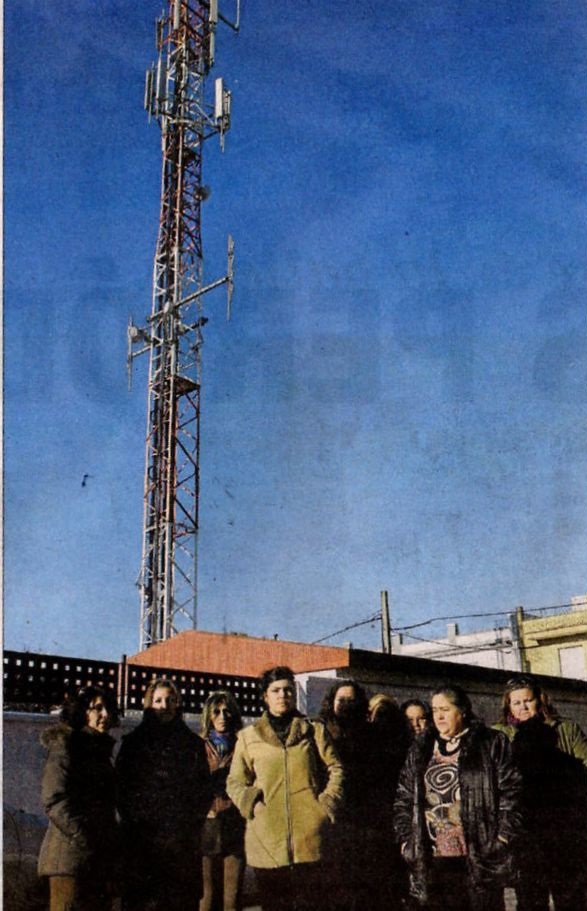Portada del sitio > Documentos > Corporate Company Investor Warnings In Annual Reports 10k Filings Cell (...)

Corporate Company Investor Warnings In Annual Reports 10k Filings Cell Phone Radiation Risks
Miércoles 16 de enero de 2019 · 6169 lecturas
Corporate Company Investor Warnings In Annual Reports 10k Filings Cell Phone Radiation Risks
Corporate Company Investor Warnings contained in Annual Reports filed on Form 10-K (or Form 20-F or 40-F for foreign companies) with the and Securities and Exchange Commission (SEC).
“We may incur significant expenses defending such suits or government charges and may be required to pay amounts or otherwise change our operations in ways that could materially adversely affect our operations or financial results.”
Cell phone manufacturers and providers of their infrastructure are aware that the radiation from their products could be risky and warn their shareholders. See below excerpts from statements in their annual reports that indicate these companies are informing their shareholders that they may incur significant financial losses related to electromagnetic fields.
AT&T Inc.
2017 Annual Report
“We are a party to numerous lawsuits, regulatory proceedings and other matters arising in the ordinary course of business. As of the date of this report, we do not believe any pending legal proceedings to which we or our subsidiaries are subject are required to be disclosed as material legal proceedings pursuant to this item.
We are subject from time to time to judicial and administrative proceedings brought by various governmental authorities under federal, state or local environmental laws. We are required to discuss below those proceedings in our Forms 10-Q and 10-K, which could result in monetary sanctions (exclusive of interest and costs) of $100,000 or more. However, we do not believe that any currently pending will have a material adverse effect on our results of operations.
Waste Disposal Inquiry Involving DIRECTV. In August 2012, a unit organized by the California Attorney General and the District Attorney for Alameda County, California notified DIRECTV that the unit was examining allegations that DIRECTV had failed to properly manage, store, transport and dispose of Hazardous and Universal Waste in accordance with the California Health & Safety Code. No litigation was filed. In November 2017, DIRECTV settled this matter for an immaterial amount and agreed to continue to abide by processes to comply with California waste regulations already implemented by AT&T affiliates in California for a period of 5 years.”
2016 Annual Report
“Unfavorable litigation or governmental investigation results could require us to pay significant amounts or lead to onerous operating procedures”
“We are subject to a number of lawsuits both in the United States and in foreign countries, including, at any particular time, claims relating to antitrust; patent infringement; wage and hour; personal injury; customer privacy violations; regulatory proceedings; and selling and collection practices. We also spend substantial resources complying with various government standards, which may entail related investigations and litigation. In the wireless area, we also face current and potential litigation relating to alleged adverse health effects on customers or employees who use such technologies including, for example, wireless devices. We may incur significant expenses defending such suits or government charges and may be required to pay amounts or otherwise change our operations in ways that could materially adversely affect our operations or financial results.”
Verizon Communications Inc.
2017 Annual Report
“We are subject to a significant amount of litigation, which could require us to pay significant damages or settlements.
We are subject to a substantial amount of litigation, including, from time to time, shareholder derivative suits, patent infringement lawsuits, antitrust class actions, wage and hour class actions, personal injury claims and lawsuits relating to our advertising, sales, billing and collection practices. In addition, our wireless business also faces personal injury and wrongful death lawsuits relating to alleged health effects of wireless phones or radio frequency transmitters. We may incur significant expenses in defending these lawsuits. In addition, we may be required to pay significant awards or settlements.”
2016 10-K ANNUAL REPORT
“We are subject to a significant amount of litigation, which could require us to pay significant damages or settlements.
…our wireless business also faces personal injury and consumer class action lawsuits relating to alleged health effects of wireless phones or radio frequency transmitters, and class action lawsuits that challenge marketing practices and disclosures relating to alleged adverse health effects of handheld wireless phones. We may incur significant expenses in defending these lawsuits. In addition, we may be required to pay significant awards or settlements.”
Crown Castle
2017 Annual Report
“If radio frequency emissions from wireless handsets or equipment on our communications infrastructure are demonstrated to cause negative health effects, potential future claims could adversely affect our operations, costs or revenues.
The potential connection between radio frequency emissions and certain negative health effects, including some forms of cancer, has been the subject of substantial study by the scientific community in recent years. We cannot guarantee that claims relating to radio frequency emissions will not arise in the future or that the results of such studies will not be adverse to us.
Public perception of possible health risks associated with cellular or other wireless connectivity services may slow or diminish the growth of wireless companies, which may in turn slow or diminish our growth. In particular, negative public perception of, and regulations regarding, these perceived health risks may slow or diminish the market acceptance of wireless services. If a connection between radio frequency emissions and possible negative health effects were established, our operations, costs, or revenues may be materially and adversely affected. We currently do not maintain any significant insurance with respect to these matters.”
2016 10-K ANNUAL REPORT
If radio frequency emissions from wireless handsets or equipment on our wireless infrastructure are demonstrated to cause negative health effects, potential future claims could adversely affect our operations, costs or revenues.
The potential connection between radio frequency emissions and certain negative health effects, including some forms of cancer, has been the subject of substantial study by the scientific community in recent years. We cannot guarantee that claims relating to radio frequency emissions will not arise in the future or that the results of such studies will not be adverse to us.
Public perception of possible health risks associated with cellular or other wireless connectivity services may slow or diminish the growth of wireless companies, which may in turn slow or diminish our growth. In particular, negative public perception of,
and regulations regarding, these perceived health risks may slow or diminish the market acceptance of wireless services. If a connection between radio frequency emissions and possible negative health effects were established, our operations, costs, or revenues may be materially and adversely affected. We currently do not maintain any significant insurance with respect to these matters.
Vodafone 2017 Report
This 2017 Report ranks the EMF health risk issue as having a “high” impact . Please see page 29 of the report for a graphic on “Our Principal Risks” that features the EMF risk as “High.” The graphic states, “EMF health related risks EMF found to pose health risks causing reduction in mobile usage or litigation.” See the Vodaphone graphic here.
In addition this Report states that:
“What is the risk? Electro-magnetic signals emitted by mobile devices and base stations may be found to pose health risks, with potential impacts including: changes to national legislation, a reduction in mobile phone usage or litigation.”
Vodafone 2017 Report
British Telecom
“Acquiring EE has also raised the exposure of our customers and staff to radio frequency emissions from wireless mobile devices and mobile telecoms sites. Media reports have suggested these emissions may cause health issues, including cancer, and may interfere with some electronic medical devices, including hearing aids and pacemakers. Research and studies are ongoing.
According to the World Health Organization’s Fact Sheet Number 193, last reviewed in October 2014, there are no known adverse effects on health from emissions at levels below internationally recognised health and safety standards. Even so, we can’t provide absolute assurance that research in the future won’t establish links between radio frequency emissions and health risks.”- BT British Telecom May 2018 Filing SEC filing
Blackberry Limited
40-F Annual Report for Fiscal Year Ended February 28, 2018
*** Important changes from 2014 report
“The Company is subject to risks related to regulations regarding health and safety, hazardous materials usage and conflict minerals, and to product certification risks.
The Company must comply with a variety of laws, standards and other requirements governing, among other things, health and safety, hazardous materials usage, packaging and environmental matters, and its products must obtain regulatory approvals and satisfy other regulatory concerns in the various jurisdictions in which they are sold. The Company is also subject to Securities and Exchange Commission (“SEC”) disclosure requirements applicable to issuers that have contracted to manufacture products containing certain minerals that are mined from the Democratic Republic of Congo and adjoining countries. There can be no assurance that the direct or indirect costs of complying with such laws, standards and requirements will not adversely affect the Company’s business, results of operations or financial condition. Any failure to comply with such laws, standards and requirements may subject the Company to regulatory or civil liability, fines or other additional costs, and reputational harm.
In addition to complying with regulatory requirements, the Company must obtain certain product approvals and certifications from governmental authorities, regulated enterprise customers and network carrier partners. Failure to maintain such approvals or certifications for the Company’s current products or to obtain such approvals or certifications for any new products on a timely basis could have a material adverse effect on the Company’s business, results of operations and financial condition.”
40-F Annual Report for the Fiscal year ended February 28, 2017
*** Important changes from 2014 report
“The Company is subject to risks related to health and safety and hazardous materials usage regulations, and to product certification risks.
The Company must comply with a variety of laws, standards and other requirements governing, among other things, health and safety, hazardous materials usage, packaging and environmental matters, and its products must obtain regulatory approvals and satisfy other regulatory concerns in the various jurisdictions in which they are sold. There can be no assurance that the costs of complying with such laws, standards and requirements will not adversely affect the Company’s business, results of operations or financial condition. Any failure to comply with such laws, standards and requirements may subject the Company to regulatory or civil liability, fines or other additional costs, and reputational harm, and may in severe cases prevent it from selling its products in certain jurisdictions.
In addition, any perceived risk of adverse health effects of mobile communication devices could materially adversely affect the Company through litigation or a reduction in sales. In addition to complying with regulatory requirements, the Company must obtain certain product approvals and certifications from governmental authorities, regulated enterprise customers and network carrier partners. Failure to maintain such approvals or certifications for the Company’s current products or to obtain such approvals or certifications for any new products on a timely basis could have a material adverse effect on the Company’s business, results of operations and financial condition.”
Blackberry Limited 2014 Report had different wording
40-F Annual Report for the fiscal year ended March 01, 2014
“The Company is subject to regulation and certification risks that could negatively affect its business, and is also subject to allegations of possible health or other risks relating to the use or misuse of the Company’s products, or lawsuits and publicity related to such allegations.
The Company must comply with a variety of laws, standards and other requirements governing, among other things, health and safety, hazardous materials usage, packaging and environmental matters, and its products must obtain regulatory approvals and satisfy other regulatory concerns in the various jurisdictions in which they are manufactured or sold. For example, the Company’s products must be approved by the FCC before they can be used in commercial quantities in the United States. The FCC requires that access devices meet various standards, including safety standards with respect to human exposure to electromagnetic radiation and basic signal leakage. Regulatory requirements in Canada, Europe, Asia and other jurisdictions must also be met. Although the Company’s products and solutions are designed to meet relevant safety standards and recommendations globally, when used as directed, any perceived risk of adverse health effects of wireless communication devices could materially adversely affect the Company through a reduction in sales.
There has also been public speculation about possible health risks to individuals from exposure to electromagnetic fields or radio frequency energy from the use of mobile devices. Government agencies, international health organizations, industry associations and other scientific bodies continue to conduct research on the topic, and there can be no assurance that future studies, irrespective of their scientific basis, will not suggest a link between electromagnetic fields from mobile devices and adverse health effects. Mobile device manufacturers and cellular services providers have been named in lawsuits alleging that the use of mobile devices poses a risk to human health and that radio emissions have caused or contributed to the development of brain tumors. Other users of mobile devices with multimedia functions, such as MP3 players, have claimed that the use of such products has contributed to or resulted in hearing loss or other adverse health effects. In addition, users of the Company’s products who disregard the Company’s warnings about using the products while operating a motor vehicle or who use aftermarket accessories, such as batteries, that are not subject to the Company’s quality control procedures may also be at risk of bodily harm. The perception of risk to human health or other risks could adversely affect the demand for the Company’s Table of Contents 51 products and allegations of risks relating to the Company’s products could result in litigation, which could distract management or result in liabilities for the Company, regardless of the merit of such claims.”
China Mobile Limited
2017 Form 20-F
“Actual or perceived health risks associated with the use of mobile devices could materially impair our ability to retain and attract customers, reduce wireless telecommunications usage or result in litigation.
There continues to be public speculation about possible health risks to individuals from exposure to electromagnetic fields from base stations and from the use of mobile devices. While a substantial amount of scientific research conducted to date by various independent research bodies has shown that radio signals, at levels within the limits prescribed by public health authority safety standards and recommendations, present no adverse effect to human health, we cannot be certain that future studies, irrespective of their relative reliability or trustworthiness, will not impute a link between electromagnetic fields and adverse health effects. Research into these issues is ongoing by government agencies, international health organizations and other scientific bodies in order to develop a better scientific understanding and public awareness of these issues. In addition, several wireless industry participants were the targets of lawsuits alleging various health consequences as a result of wireless phone usage or seeking protective measures. While we are not aware of any scientific studies or objective evidence which substantiates such alleged health risks, we cannot assure you that the actual, or perceived, risks associated with radio wave transmission will not materially impair our ability to retain customers and attract new customers, significantly reduce wireless telecommunications usage or result in litigation.”
2016 Form 20-F
“Actual or perceived health risks associated with the use of mobile devices could materially impair our ability to retain and attract customers, reduce wireless telecommunications usage or result in litigation.
There continues to be public speculation about possible health risks to individuals from exposure to electromagnetic fields from base stations and from the use of mobile devices. While a substantial amount of scientific research conducted to date by various independent research bodies has shown that radio signals, at levels within the limits prescribed by public health authority safety standards and recommendations, present no adverse effect to human health, we cannot be certain that future studies, irrespective of their relative reliability or trustworthiness, will not impute a link between electromagnetic fields and adverse health effects. Research into these issues is ongoing by government agencies, international health organizations and other scientific bodies in order to develop a better scientific understanding and public awareness of these issues. In addition, several wireless industry participants were the targets of lawsuits alleging various health consequences as a result of wireless phone usage or seeking protective measures. While we are not aware of any scientific studies or objective evidence which substantiates such alleged health risks, we cannot assure you that the actual, or perceived, risks associated with radio wave transmission will not materially impair our ability to retain customers and attract new customers, significantly reduce wireless telecommunications usage or result in litigation.”
American Tower Corporation
2017 Annual Report
“Our costs could increase and our revenues could decrease due to perceived health risks from radio emissions, especially if these perceived risks are substantiated.
Public perception of possible health risks associated with cellular and other wireless communications technology could slow the growth of wireless companies, which could in turn slow our growth. In particular, negative public perception of, and regulations regarding, these perceived health risks could undermine the market acceptance of wireless communications services and increase opposition to the development and expansion of tower sites. If a scientific study or court decision or government agency ruling resulted in a finding that radio frequency emissions pose health risks to consumers, it could negatively impact our tenants and the market for wireless services, which could materially and adversely affect our business, results of operations or financial condition. We do not maintain any significant insurance with respect to these matters.”
2016 Annual Report
“Our costs could increase and our revenues could decrease due to perceived health risks from radio emissions, especially if these perceived risks are substantiated.
Public perception of possible health risks associated with cellular and other wireless communications technology could slow the growth of wireless companies, which could in turn slow our growth. In particular, negative public perception of, and regulations regarding, these perceived health risks could undermine the market acceptance of wireless communications services and increase opposition to the development and expansion of tower sites. If a scientific study or court decision resulted in a finding that radio frequency emissions pose health risks to consumers, it could negatively impact our tenants and the market for wireless services, which could materially and adversely affect our business, results of operations or financial condition. We do not maintain any significant insurance with respect to these matters.”
AMÉRICA MÓVIL, S.A.B. DE C.V.
2017 Form 20-F Annual Report
“Concerns about health risks relating to the use of wireless handsets and base stations may adversely affect our business.
Portable communications devices have been alleged to pose health risks, including cancer, due to radio frequency emissions. Lawsuits have been filed in the United States against certain participants in the wireless industry alleging various adverse health consequences as a result of wireless phone usage, and our subsidiaries may be subject to similar litigation in the future. Research and studies are ongoing, and there can be no assurance that further research and studies will not demonstrate a link between radio frequency emissions and health concerns. Any negative findings in these studies could adversely affect the use of wireless technology and, as a result, our future financial performance.”
2016 Form 20-F Annual Report
“Concerns about health risks relating to the use of wireless handsets and base stations may adversely affect our business.
Portable communications devices have been alleged to pose health risks, including cancer, due to radio frequency emissions. Lawsuits have been filed in the United States against certain participants in the wireless industry alleging various adverse health consequences as a result of wireless phone usage, and our subsidiaries may be subject to similar litigation in the future. Research and studies are ongoing, and there can be no assurance that further research and studies will not demonstrate a link between radio frequency emissions and health concerns. Any negative findings in these studies could adversely affect the use of wireless technology and, as a result, our future financial performance.”
T-Mobile US, Inc.
2017 Annual Report
“Our business could be adversely affected by findings of product liability for health/safety risks from wireless devices and transmission equipment, as well as by changes to regulations/radio frequency emission standards.
We do not manufacture the devices or other equipment that we sell, and we depend on our suppliers to provide defect-free and safe equipment. Suppliers are required by applicable law to manufacture their devices to meet certain governmentally imposed safety criteria. However, even if the devices we sell meet the regulatory safety criteria, we could be held liable with the equipment manufacturers and suppliers for any harm caused by products we sell if such products are later found to have design or manufacturing defects. We generally seek to enter into indemnification agreements with the manufacturers who supply us with devices to protect us from losses associated with product liability, but we cannot guarantee that we will be fully protected against all losses associated with a product that is found to be defective.
Allegations have been made that the use of wireless handsets and wireless transmission equipment, such as cell towers, may be linked to various health concerns, including cancer and brain tumors. Lawsuits have been filed against manufacturers and carriers in the industry claiming damages for alleged health problems arising from the use of wireless handsets. In addition, the FCC has from time to time gathered data regarding wireless handset emissions and its assessment of this issue may evolve based on its findings. The media has also reported incidents of handset battery malfunction, including reports of batteries that have overheated. These allegations may lead to changes in regulatory standards. There have also been other allegations regarding wireless technology, including allegations that wireless handset emissions may interfere with various electronic medical devices (including hearing aids and pacemakers), airbags and anti-lock brakes. Defects in the products of our suppliers, such the 2016 recalls by a handset Original Equipment Manufacturer (“OEM”) on one of its smartphone devices, could have a material adverse effect on our business, financial condition and operating results.
Additionally, there are safety risks associated with the use of wireless devices while operating vehicles or equipment. Concerns over any of these risks and the effect of any legislation, rules or regulations that have been and may be adopted in response to these risks could limit our ability to sell our wireless services.”
2016 Form 10-K Annual Report
“Our business could be adversely affected by findings of product liability for health/safety risks from wireless devices and transmission equipment, as well as by changes to regulations/radio frequency emission standards.
We do not manufacture the devices or other equipment that we sell, and we depend on our suppliers to provide defect-free and safe equipment. Suppliers are required by applicable law to manufacture their devices to meet certain governmentally imposed safety criteria. However, even if the devices we sell meet the regulatory safety criteria, we could be held liable with the equipment manufacturers and suppliers for any harm caused by products we sell if such products are later found to have design or manufacturing defects. We generally seek to enter into indemnification agreements with the manufacturers who supply us with devices to protect us from losses associated with product liability, but we cannot guarantee that we will be fully protected against all losses associated with a product that is found to be defective.
Allegations have been made that the use of wireless handsets and wireless transmission equipment, such as cell towers, may be linked to various health concerns, including cancer and brain tumors. Lawsuits have been filed against manufacturers and carriers in the industry claiming damages for alleged health problems arising from the use of wireless handsets. In addition, the FCC has from time to time gathered data regarding wireless handset emissions and its assessment of this issue may evolve based on its findings. The media has also reported incidents of handset battery malfunction, including reports of batteries that have overheated. These allegations may lead to changes in regulatory standards. There have also been other allegations regarding wireless technology, including allegations that wireless handset emissions may interfere with various electronic medical devices (including hearing aids and pacemakers), airbags and anti-lock brakes. Defects in the products of our suppliers, such the recent recalls by a handset Original Equipment Manufacturer (“OEM”) on one of its smartphone devices, could have an adverse impact on our operating results.
Additionally, there are safety risks associated with the use of wireless devices while operating vehicles or equipment. Concerns over any of these risks and the effect of any legislation, rules or regulations that have been and may be adopted in response to these risks could limit our ability to sell our wireless services.”
GCI INC
2017 Annual Report
“Concerns about health/safety risks associated with wireless equipment may reduce the demand for our wireless services.
We do not manufacture devices or other equipment sold by us, and we depend on our suppliers to provide defect-free and safe equipment. Suppliers are required by applicable law to manufacture their devices to meet certain governmentally imposed safety criteria. However, even if the devices we sell meet the regulatory safety criteria, we could be held liable with the equipment manufacturers and suppliers for any harm caused by products we sell if such products are later found to have design or manufacturing defects. We cannot guarantee that we will be fully protected against all losses associated with a product that is found to be defective.
Portable communications devices have been alleged to pose health risks, including cancer, due to radio frequency emissions from these devices. Purported class actions and other lawsuits have been filed from time to time against other wireless companies seeking not only damages but also remedies that could increase the cost of doing business. We cannot be sure of the outcome of any such cases or that the industry will not be adversely affected by litigation of this nature or public perception about health risks. The actual or perceived risk of mobile communications devices could adversely affect us through a reduction in subscribers. Further research and studies are ongoing, with no linkage between health risks and mobile phone use established to date by a credible public source. However, we cannot be sure that additional studies will not demonstrate a link between radio frequency emissions and health concerns.
Additionally, there are safety risks associated with the use of wireless devices while operating vehicles or equipment. Concerns over any of these risks and the effect of any legislation, rules or regulations that have been and may be adopted in response to these risks could limit our ability to sell our wireless services.”
2016 Form 10-K Annual Report
“Concerns about health/safety risks associated with wireless equipment may reduce the demand for our wireless services.
We do not manufacture devices or other equipment sold by us, and we depend on our suppliers to provide defect-free and safe equipment. Suppliers are required by applicable law to manufacture their devices to meet certain governmentally imposed safety criteria. However, even if the devices we sell meet the regulatory safety criteria, we could be held liable with the equipment manufacturers and suppliers for any harm caused by products we sell if such products are later found to have design or manufacturing defects. We cannot guarantee that we will be fully protected against all losses associated with a product that is found to be defective.
Portable communications devices have been alleged to pose health risks, including cancer, due to radio frequency emissions from these devices. Purported class actions and other lawsuits have been filed from time to time against other wireless companies seeking not only damages but also remedies that could increase the cost of doing business. We cannot be sure of the outcome of any such cases or that the industry will not be adversely affected by litigation of this nature or public perception about health risks. The actual or perceived risk of mobile communications devices could adversely affect us through a reduction in subscribers. Further research and studies are ongoing, with no linkage between health risks and mobile phone use established to date by a credible public source. However, we cannot be sure that additional studies will not demonstrate a link between radio frequency emissions and health concerns.
Additionally, there are safety risks associated with the use of wireless devices while operating vehicles or equipment. Concerns over any of these risks and the effect of any legislation, rules or regulations that have been and may be adopted in response to these risks could limit our ability to sell our wireless services.”
TELEFÓNICA, S.A.
2017 Form 20-F Annual Report
“The telecommunications industry may be affected by the possible effects that electromagnetic fields, emitted by mobile devices and base stations, may have on human health.
In some countries, there is a concern regarding potential effects of electromagnetic fields, emitted by mobile devices and base stations, on human health. This public concern has caused certain governments and administrations to take measures that have hindered the deployment of the infrastructures necessary to ensure quality of service, and affected the deployment criteria of new networks and digital services such as smart meters development.
There is a consensus between certain expert groups and public health agencies, including the World Health Organization that states that currently there are no established risks associated with exposure to low frequency signals in mobile communications. However, the scientific community is still investigating this issue especially with respect to mobile devices. Exposure limits for radio frequency suggested in the guidelines of the Protection of Non-Ionizing Radiation Protection Committee have been internationally recognized. The mobile industry has adopted these exposure limits and works to request authorities worldwide to adopt these standards.
Worries about radio frequency emissions may discourage the use of mobile devices and new digital services, which could cause the public authorities to implement measures restricting where transmitters and cell sites can be located, how they operate, the use of mobile telephones and the massive deployment of smart meters and other products using mobile technology. This could lead to Telefónica being unable to expand or improve its mobile network.
The adoption of new measures by governments or administrations or other regulatory interventions in this respect, and any future assessment on the adverse impact of electromagnetic fields on health, may adversely affect the business, financial conditions, results of operations and cash flows of the Telefónica Group.”
2016 Form 20-F Annual Report
“The telecommunications industry may be affected by the possible effects that electromagnetic fields, emitted by mobile devices and base stations, may have on human health.
In some countries, there is a concern regarding potential effects of electromagnetic fields, emitted by mobile devices and base stations, on human health. This public concern has caused certain governments and administrations to take measures that have hindered the deployment of the infrastructures necessary to ensure quality of service, and affected the deployment criteria of new networks and digital services such as smart meters development.
There is a consensus between certain expert groups and public health agencies, including the World Health Organization that states that currently there are no established risks associated with exposure to low frequency signals in mobile communications. However, the scientific community is still investigating this issue especially with respect to mobile devices. Exposure limits for radio frequency suggested in the guidelines of the Protection of Non-Ionizing Radiation Protection Committee have been internationally recognized. The mobile industry has adopted these exposure limits and works to request authorities worldwide to adopt these standards.
Worries about radio frequency emissions may discourage the use of mobile devices and new digital services, which could cause the public authorities to implement measures restricting where transmitters and cell sites can be located, how they operate, the use of mobile telephones and the massive deployment of smart meters and other products using mobile technology. This could lead to Telefónica being unable to expand or improve its mobile network.
The adoption of new measures by governments or administrations or other regulatory interventions in this respect, and any future assessment on the adverse impact of electromagnetic fields on health, may adversely affect the business, financial conditions, results of operations and cash flows of the Telefónica Group.”
CROWN CASTLE INTERNATIONAL CORP.
2016 Form 10-K Annual Report
“If radio frequency emissions from wireless handsets or equipment on our wireless infrastructure are demonstrated to cause negative health effects, potential future claims could adversely affect our operations, costs or revenues.
The potential connection between radio frequency emissions and certain negative health effects, including some forms of cancer, has been the subject of substantial study by the scientific community in recent years. We cannot guarantee that claims relating to radio frequency emissions will not arise in the future or that the results of such studies will not be adverse to us.
Public perception of possible health risks associated with cellular or other wireless connectivity services may slow or diminish the growth of wireless companies, which may in turn slow or diminish our growth. In particular, negative public perception of, 12 and regulations regarding, these perceived health risks may slow or diminish the market acceptance of wireless services. If a connection between radio frequency emissions and possible negative health effects were established, our operations, costs, or revenues may be materially and adversely affected. We currently do not maintain any significant insurance with respect to these matters.”
SoftBank Group Corp.
(SoftBank is a corporate group comprising the pure holding company SoftBank Corp. and 756 subsidiaries including Sprint, Wireless City Planning and Yahoo Japan. They consolidated Sprint in 2013.)
2017 Annual Report
“Regulations about health risks associated with electromagnetic waves. There have been some research results that have indicated the possibility that electromagnetic waves emitted from mobile devices and base stations have adverse health effects, such as increasing the risk of cancer. The International Commission on Non-Ionizing Radiation Protection (ICNIRP) has prescribed guidelines relating to the amplitudes of these electromagnetic waves. The World Health Organization (WHO) has issued an opinion that there is no convincing evidence that electromagnetic waves have adverse effects on health when their amplitude is within the reference values in the ICNIRP’s guidelines, and recommends that all countries adopt them. The Group complies with a policy for protection from electromagnetic waves based on the ICNIRP guidelines in Japan, and complies with the requirements of the Federal Communications Commission (FCC) in the U.S. However, the WHO and other organizations continue to conduct research and investigations, the results of which may lead to regulations being revised in the future, or new regulations being introduced. Complying with such revision or introduction of regulations may incur costs, or may restrict the Group’s business operations, which could impact the Group’s results of operations. Moreover, regardless of the presence of such regulations, concerns over the adverse effects on health associated with use of mobile devices could make it difficult for the Group to acquire and retain customers, which could impact the Group’s results of operations.”
2014 Annual Report
“Concerns about health risks associated with mobile devices
There have been claims made that the radio waves emitted from mobile devices have adverse health effects, such as increasing the risk of cancer. Such concerns over adverse effects on health associated with use of mobile devices could make it difficult for the Group to acquire and retain customers, which could impact the Group’s results of operations. The International Commission on Non-Ionizing Radiation Protection (ICNIRP) has prescribed guidelines relating to the amplitudes of the electromagnetic waves emitted from mobile devices and base stations. The World Health Organization (WHO) has issued an opinion that there is no convincing evidence that electromagnetic waves have adverse effects on health when their amplitude is within the reference values in the ICNIRP’s guidelines, and recommends that all countries adopt them. The Group complies with a policy for protection from electromagnetic waves based on the ICNIRP guidelines in Japan, and complies with the requirements of the Federal Communications Commission (FCC) in the U.S. However, the WHO and other organizations continue to conduct research and investigations, the results of which may lead to regulations being revised in the future, or new regulations being introduced.”
Nokia Corporation
2017 Annual Report
*** Important changes made from 2014 report
“An unfavorable outcome of litigation, arbitrations, agreement-related disputes or product liability-related allegations against our business could have a material adverse effect on us.
We are a party to lawsuits, arbitrations, agreement-related disputes and product liability-related allegations in the normal course of our business. Litigation, arbitration or agreement-related disputes can be expensive, lengthy and disruptive to normal business operations and divert the efforts of our management. Moreover, the outcomes of complex legal proceedings or agreement-related disputes are difficult to predict. An unfavorable resolution of a particular lawsuit, arbitration or agreement-related dispute could have a material adverse effect on our business, results of operations, financial condition and reputation. The investment or acquisition decisions we make may subject us to litigation arising from minority shareholders’ actions and investor dissatisfaction with the activities of our business. Shareholder disputes, if resolved against us, could have a material adverse effect on our financial condition and results of operations as well as expose us to disputes or litigation.
We record provisions for pending claims when we determine that an unfavorable outcome is likely and the loss can reasonably be estimated. Due to the inherent uncertain nature of legal proceedings, the ultimate outcome or actual cost of settlement may materially differ from estimates. We believe our provisions for pending claims are appropriate. The ultimate outcome, however, may differ from the provided estimate, which could have either a positive or an adverse impact on our results of operations and financial condition.
Although our products are designed to meet all relevant safety standards and other recommendations and regulatory requirements globally, we cannot guarantee we will not become subject to product liability claims or be held liable for such claims or be required to comply with future regulatory changes in this area, which could have a material adverse effect on our business and financial condition. We have been involved in several lawsuits alleging adverse health effects associated with our products, including those caused by electromagnetic fields, and the outcome of such procedures is difficult to predict, including potentially significant fines or settlements. Even a perceived risk of adverse health effects of mobile devices or base stations could have a material adverse effect on us through a reduction in the demand for mobile devices having an adverse effect, for instance, through a decreased demand for mobile networks or increased difficulty in obtaining sites for base stations.
For a more detailed discussion of litigation to which we are a party, refer to Note 29, Provisions, of our consolidated financial statements included in this annual report on Form 20-F.”
2016 Annual Report
*** Important changes made from 2014 report
“Regulations about health risks associated with electromagnetic waves.
There have been some research results that have indicated the possibility that electromagnetic waves emitted from mobile devices and base stations have adverse health effects, such as increasing the risk of cancer. The International Commission on Non-Ionizing Radiation Protection (ICNIRP) has prescribed guidelines relating to the amplitudes of these electromagnetic waves. The World Health Organization (WHO) has issued an opinion that there is no convincing evidence that electromagnetic waves have adverse effects on health when their amplitude is within the reference values in the ICNIRP’s guidelines, and recommends that all countries adopt them. The Group complies with a policy for protection from electromagnetic waves based on the ICNIRP guidelines in Japan, and complies with the requirements of the Federal Communications Commission (FCC) in the U.S. However, the WHO and other organizations continue to conduct research and investigations, the results of which may lead to regulations being revised in the future, or new regulations being introduced. Complying with such revision or introduction of regulations may incur costs, or may restrict the Group’s business operations, which could impact the Group’s results of operations. Moreover, regardless of the presence of such regulations, concerns over the adverse effects on health associated with use of mobile devices could make it difficult for the Group to acquire and retain customers, which could impact the Group’s results of operations.” – pg. 71
2014 Annual Report
“An unfavorable outcome of litigation…allegations of health hazards associated with our businesses could have a material adverse effect on us.
Although NOKIA products are designed to meet all relevant safety standard and recommendations globally, we cannot guarantee we will not become subject to product liability claims or be held liable for such claims or be required to comply with future regulatory changes in this area, and these could have a material adverse effect on our business. ‘ “We have been involved in several lawsuits alleging adverse health effects associated with our products, including those caused by electromagnetic fields and the outcome of such procedures is difficult to predict, including the potentially significant fines or settlements.” “Even a perceived risk of adverse health effects of mobile devices or base stations could have a material adverse affect on us through reduction in the demand for mobile devices having an adverse effect, for instance through decreased demand for mobile networks or increased difficulty in obtaining sites for base stations.”
Microsoft Corporation
2017 Annual Report
“U.S. cell phone litigation
Nokia, along with other handset manufacturers and network operators, is a defendant in 19 lawsuits filed in the Superior Court for the District of Columbia by individual plaintiffs who allege that radio emissions from cellular handsets caused their brain tumors and other adverse health effects. We assumed responsibility for these claims as part of our acquisition of Nokia’s Devices and Services business and have been substituted for the Nokia defendants. Nine of these cases were filed in 2002 and are consolidated for certain pre-trial proceedings; the remaining 10 cases are stayed. In a separate 2009 decision, the Court of Appeals for the District of Columbia held that adverse health effect claims arising from the use of cellular handsets that operate within the U.S. Federal Communications Commission radio frequency emission guidelines (“FCC Guidelines”) are pre-empted by federal law. The plaintiffs allege that their handsets either operated outside the FCC Guidelines or were manufactured before the FCC Guidelines went into effect. The lawsuits also allege an industry-wide conspiracy to manipulate the science and testing around emission guidelines.
In 2013, defendants in the consolidated cases moved to exclude plaintiffs’ expert evidence of general causation on the basis of flawed scientific methodologies. In 2014, the trial court granted in part and denied in part defendants’ motion to exclude plaintiffs’ general causation experts. The defendants filed an interlocutory appeal challenging the standard for evaluating expert scientific evidence, which the District of Columbia Court of Appeals heard en banc. In October 2016, the Court of Appeals issued its decision adopting the standard advocated by defendants and remanding the cases to the trial court for further proceedings under that standard. Plaintiffs have filed a motion to reopen discovery and file additional expert evidence.
Canadian cell phone class action
Nokia, along with other handset manufacturers and network operators, is a defendant in a 2013 class action lawsuit filed in the Supreme Court of British Columbia by a purported class of Canadians who have used cellular phones for at least 1,600 hours, including a subclass of users with brain tumors. Microsoft was served with the complaint in June 2014 and has been substituted for the Nokia defendants. The litigation has been dormant for more than two years.”
2016 Annual Report
“U.S. cell phone litigation
Nokia, along with other handset manufacturers and network operators, is a defendant in 19 lawsuits filed in the Superior Court for the District of Columbia by individual plaintiffs who allege that radio emissions from cellular handsets caused their brain tumors and other adverse health effects. We assumed responsibility for these claims as part of the NDS acquisition and have been substituted for the Nokia defendants. Nine of these cases were filed in 2002 and are consolidated for certain pre-trial proceedings; the remaining 10 cases are stayed. In a separate 2009 decision, the Court of Appeals for the District of Columbia held that adverse health effect claims arising from the use of cellular handsets that operate within the U.S. Federal Communications Commission radio frequency emission guidelines (“FCC Guidelines”) are pre-empted by federal law. The plaintiffs allege that their handsets either operated outside the FCC Guidelines or were manufactured before the FCC Guidelines went into effect. The lawsuits also allege an industry-wide conspiracy to manipulate the science and testing around emission guidelines.”
Telstra
2017 Annual Report
“Mobile phones, base stations and health
We acknowledge that some people are concerned about possible health effects from electromagnetic energy (EME), and we are committed to addressing these concerns responsibly. We are proactive, transparent and fact based in our communications regarding EME and comply with the standards set by regulators. We rely on the expert advice of national and international health authorities including the Australian Radiation Protection and Nuclear Safety Agency (ARPANSA) and the World Health Organization (WHO) and actively contribute to scientific research in the area.
“Helping our customers and the community keep abreast of the latest information is important to us. This year, we continued our mobile safety SMS campaign, sending out over 17 million messages referring customers to telstra.com.au/mobiletips, where we have information on mobile use, EME, and tips to reduce exposure. We provide information on EME on our website at telstra.com/eme and have a dedicated EME help desk and team that proactively reviews new site proposals, develops community consultation plans and works with the community to determine acceptable sites for new base stations.”
2016 Annual Report
“Mobile phones, base stations and health
We acknowledge that some people are concerned about possible health effects from electromagnetic energy (EME), and we are committed to addressing these concerns responsibly. We are proactive, transparent and fact based in our communications regarding EME and comply with the standards set by regulators. We rely on the expert advice of national and international health authorities including the Australian Radiation Protection and Nuclear Safety Agency (ARPANSA) and the World Health Organization (WHO) and actively contribute to scientific research in EME and health.
Helping our customers and the community keep abreast of the latest information is important to us. We provide information on EME on our website at telstra.com/ eme. We also invite customers to go directly to the WHO, ARPANSA and ‘EMF Explained’ websites for further information. This year, we continued our mobile safety SMS campaign, sending out almost 17 million messages referring customers to telstra.com/mobiletips, our information site for safe and responsible phone use.
We have a dedicated EME help desk and team that proactively reviews new site proposals, develops community consultation plans and works with the community to determine acceptable sites for new base stations.”
VODAFONE GROUP PUBLIC LTD CO
2017 Annual Report
“Electro-magnetic fields related health risks
What is the impact?
This is an unlikely risk; however, it would have a major impact on services used by our customers in all our markets – particularly in countries that have a very low tolerance for environmental and health related risks.
What is our target tolerance position?
Vodafone does not want to expose anyone to EMF levels above those mandated by regulators.
We comply with national standards, where existing, and with our own EMF policy, based on international science guidelines. Our vision is to lead within the industry in responding to public concern about mobiles, masts and health.
Who do we manage it?
Our Group EMF Board manages potential risks through cross sector initiatives and oversees a global programme to respond to public concern.
We monitor scientific developments and engage with relevant bodies to support the delivery and transparent communication of the scientific research agenda set by the World health Organization.
Key risk indicators
We monitor:
Scientific research
International standards and guidelines
Public perception
Compliance with EMF policies”
Annual Report 2016
“EMF related health risks:
What is the risk?
Concerns have been expressed that electromagnetic signals emitted by mobile telephone handsets and base stations may pose health risks. Authorities, including the World Health Organization (‘WHO’) agree there is no evidence that convinces experts that exposure to radio frequency fields from mobile devices and base stations operated within guideline limits has any adverse health effects. A change to this view could result in a range of impacts from a change to national legislation, to a major reduction in mobile phone usage or to major litigation.
How could it impact us?
This is an unlikely risk; however, it would have a major impact on services used by our customers in all our markets – particularly in countries that have a very low tolerance for environmental and health-related risks.
2015 VODAFONE GROUP PUBLIC LTD CO
There have been no significant changes to this risk over the last 12 months.
How do we manage it?
We have a global health and safety policy that includes standards for electromagnetic fields (‘EMF’) that are mandated in all our local markets. Compliance to this policy is monitored and overseen by the Risk and Compliance Committee.
We have a Group EMF Board that manages potential risks through cross sector initiatives and which oversees a coordinated global programme to respond to public concern, and develop appropriate advocacy related to possible precautionary legislation.
We monitor scientific developments and engage with relevant bodies to support the delivery and transparent communication of the scientific research agenda set by the WHO.”







